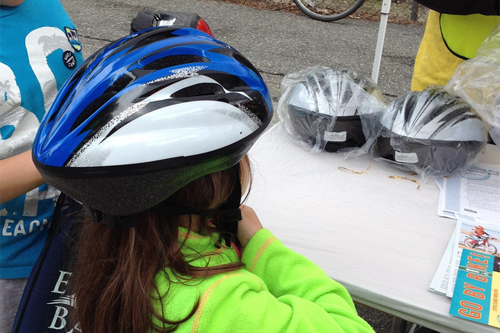Posts Tagged ‘Boston’
Massachusetts Lawyers Weekly Features Breakstone, White & Gluck’s Bike Helmet Donations
Breakstone, White & Gluck was recently mentioned in Massachusetts Lawyers Weekly for our bike helmet donations to children and for attorney David White’s “Volunteer of the Year” award from Boston Bikes, a program of the City of Boston.
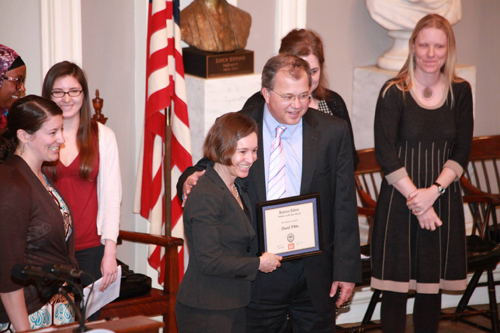 Photo credit: LivableStreets/www.livablestreets.info. Attorney David W. White of Breakstone, White & Gluck and Nicole Freedman, Director of Boston Bikes, during the 6th Annual Boston Bike Update at Faneuil Hall.
Photo credit: LivableStreets/www.livablestreets.info. Attorney David W. White of Breakstone, White & Gluck and Nicole Freedman, Director of Boston Bikes, during the 6th Annual Boston Bike Update at Faneuil Hall.
Read More
Pool Safety Starts with Your Pool Fence
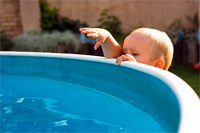
As a pool owner, you have a responsibility to secure your pool with a strong, adequate fence. Many property owners do so because it is the law and to prevent neighborhood children or trespassers from breaking in. But they may have a false security when it comes to friends, families and young children they invite over.
Many pool accidents and drownings actually involve invited guests, people we may know well and have over regularly. Let them enjoy your home, but block unrestricted and unsupervised access to your pool.
The Consumer Product Safety Commission (CPSC) conducted a survey of swimming pool accidents in Arizona, California and Florida. Data showed drowning was the leading cause of accidental death in and around the home for children under age 5. Most of these children – 75 percent – were between 1 and 3 years old.
Fewer than two percent of pool accidents resulted from children trespassing on the property. More often, children knew the pool owner, with 65 percent of accidents occurring in pools owned by an immediate family member. Another 33 percent happened in pools owned by relatives and friends.
More telling is what happened before these accidents:
- Most of the children were being supervised by at least one parent when they drowned
- Nearly half of the children were last seen in the house before the pool accident occurred
- Another 23 percent were last seen on the porch or patio, or in the yard
- Some 77 percent of children had been missing for 5 minutes or less when they were found
Adding an extra layer of fencing may make a difference in preventing these accidents.
Pool Fence Recommendations
- Self-Closing. A pool fence should be self-closing and self-latching. It should open from the pool side and should be maintained so it can easily latch.
- Fence Height. A pool fence should be at least four feet tall and four feet above the grade of the ground outside the fence.
- Release Mechanism. You want to prevent children from reaching the latch. When the release mechanism is less than 54 inches above the grade, the release mechanism for the gate should be at least 3 inches below the top of the gate and installed on the side facing the pool. Also, make sure there is no opening greater than ½ inch within 18 inches of the latch release mechanism.
- Bottom of the Fence. If your fence stands on a concrete surface, the clearance between the bottom of the fence and the ground should not exceed four inches. For fences on softer surfaces, such as grass, the maximum clearance is two inches.
- Fence Spacing. The space between the vertical fence slats should not exceed four inches.
- Chain Link Fences. For chain-link fences, the diamond-shaped openings should be no larger than 1 ¾ inches.
- Decorative Fences. Fencing with decorative openings should follow the same standard as chain link fences and not exceed 1 ¾ inch.
- Backyard Doors. Massachusetts requires pool alarms when doors from a home open into a pool enclosure area. For instance, if there are three sides of fencing around the pool and the home serves as the fourth side.
- Pool Alarms. Purchase a pool alarm even if you are not required to by law. Pool drownings happen quickly and often silently. A pool alarm interrupts that process and provides you warning if someone is entering the gate.
- Above Ground Pools. For above ground pools, build a fence on top of the structure as a barrier. Remove or lock the pool ladder when not in use. For another layer of protection, you can also add a fencing structure around the ladder and lock that when not in use.
- Pool Covers. Consider a power pool safety cover to add another layer of protection. Purchase one which conforms to the specifications in ASTMF 1346-91.
Related:
Safety Barrier Guidelines for Home Pools, Consumer Product Safety Commission
About Breakstone, White & Gluck
Our Boston personal injury lawyers have over 100 years combined experience handling personal injury and premises liability claims, including swimming pool accidents. If you or a family member has been injured, it is important to learn your rights. For a free legal consultation, contact us at 800-379-1244 or 617-723-7676 or use our contact form.
Talk to Your Loved Ones About Supervising Children by the Pool. This is the Most Important Job of Summer.
The long and lazy days of summer are finally here and many of us are spending them by the pool. We hope you enjoy these times with your friends and family. And please remember to think about safety.
Each year in the U.S., nearly 5,000 children under age 15 are treated for pool- or spa-related injuries at hospital emergency rooms, according to the Consumer Product Safety Commission (CPSC). Nearly 400 children under age 15 are killed in swimming pool and spa drownings. More than 75 percent of these children are under the age of 5 and the majority of these deaths occur at private residences. But injuries can happen at any pool where someone stops paying attention or is negligent, including hotel swimming pools, community centers and other places.
Prevent injuries this summer by talking about the rules of safety with your family and friends.
Pool Owners. You have a responsibility to keep your pool area safe for family and invited guests and to secure it from others. You must keep your pool behind a fence which is at least four feet tall and secures with a self-latching and self-closing gate. But we encourage you to go a step further. Try walking around your fenced-in pool area. Are there areas where a young child could easily get in on their own? If so, make adjustments.
If you have questions, a good resource is your town’s local building department.
Drain Covers. Keep children away from pool drains, pipes and other openings which could cause entrapment.
Home Spa Safety. If you have a home spa, install and use a child-proof locked safety cover to keep children out.
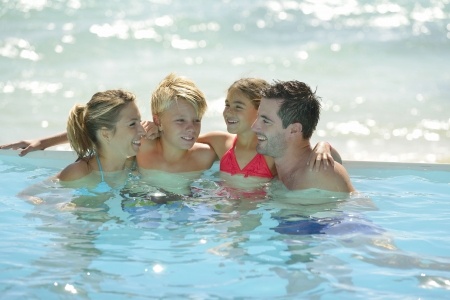
Watch Children Closely. Before the swimming season, learn CPR. Then when you head to the pool, set aside all distractions and watch the children. Avoid distractions such as reading, cell phone calls, and texting–supervision should be treated like a job.
When supervising young children, swim with them and practice “touch supervision.” For older children, watch them and be involved with them even if you are not swimming. Talk to them and let them know if they are doing something they should not be. If you are part of a group of adults watching children swim, designate someone the “pool watcher” so that the children are supervised at all times. But still supervise your own children at all times.
Likewise, at hotel and community pools, do not rely on lifeguards to watch your children.
Dress Children Appropriately. Make sure children are not wearing swimming suits or hair accessories that can get caught in pool drains or other openings.

Poolside Toys. Many pool accidents involve diving board, sports equipment, rafts and pool slides. Always look before you use. If something looks unsteady, do not use it.
Many pools no longer have diving boards because homeowner’s insurance companies have stopped providing coverage for them. But if you are going to dive, make sure the water is at least 10 feet deep.
Avoid portable pool slides, inflatable toys and using backyard trampolines with the pool. These products may not be designed for use with a pool or may be defective. In one Massachusetts case, a Colorado woman visiting the state died in 2006 after she slid down a Banzai brand inflatable slide at a backyard pool. It partially deflated, causing her to strike her head on concrete by the pool. The Consumer Product Safety Commission later recalled 21,000 of the Banzai brand inflatable slides and continues to recall unsafe pool toys and equipment each year.
Broken Glass. Do not bring beer bottles and glass out to the pool. Serious accidents can happen if the glass breaks in or near the pool and someone steps in it. If there is broken glass in the pool, it will be invisible and therefore impossible to find safely. Beyond injury, you will have a lot of clean-up. First you will have to drain the pool and then you will have to sweep it thoroughly.
Read More
Breakstone, White & Gluck Makes Bike Helmet Donation to Somerville Schools
We want to share articles from the Somerville News Weekly and BostonNewsGroup.com about the CYCLE Kids program and our bike helmet donation to the Somerville elementary schools. CYCLE Kids is a Cambridge organization which provides curriculum that teaches riding skills, bike maintenance, road safety and nutrition. Locally, the curriculum is offered in Cambridge and Somerville schools as part of physical education classes.
Earlier this week, attorney Marc Breakstone attended a graduation ceremony for children finishing the curriculum at the Dr. Albert F. Argenziano School in Somerville. Breakstone, White & Gluck donated 325 helmets to Somerville schools.
“Our firm is honored to be associated with CYCLE Kids which does such an incredible job educating kids in bike safety and healthy lifestyle choices,” Breakstone said. “The energy, excitement and elation in that gym were inspiring and many people should be recognized. Our firm looks forward to continuing to support this effort for years to come.”
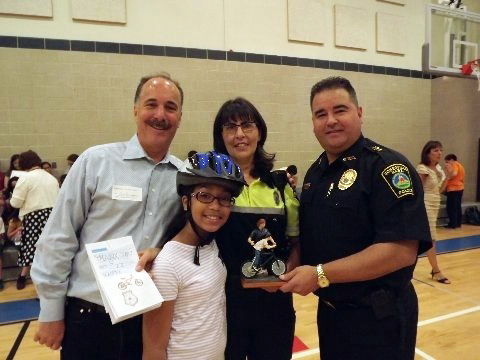
Attorney Marc Breakstone, Somerville Community Police Officer Marianne Manfra and Somerville Deputy Police Chief Michael Carbral with a graduate. Photo credit: The Somerville News Weekly.
 Fifth-graders at Somerville’s Dr. Albert F. Argenziano School graduating from CYCLE Kids program, joined by community officials.
Fifth-graders at Somerville’s Dr. Albert F. Argenziano School graduating from CYCLE Kids program, joined by community officials.
Participating in the event were Somerville Mayor Joseph Curtatone, Superintendent of Schools Anthony Pierantozzi, Deputy Police Chief Michael Cabral, Somerville Community Police Officer Marianne Manfra and CYCLE Kids Founder Julianne Idlet.
Breakstone, White & Gluck is donating bike helmets to cycling organizations throughout the Boston area in 2014. It is the second year we have made these donations and expect to donate 2,000 helmets by year’s end. We have donated helmets to Boston Bikes’ Roll It Forward, CYCLE Kids, the Kiwanis Club of Somerville and Worcester Earn-a-Bike along with other organizations.
It is our second year partnering with CYCLE Kids. Last year, we partnered with the organization and donated 300 helmets to fourth-graders in the CYCLE Kids program in Cambridge.
While CYCLE Kids is based in Cambridge, it is a national organization that promotes healthy lifestyles for youth and families. CYCLE Kids uses the bicycle as the vehicle to teach the importance of adopting healthy, active lifestyles. The CYCLE Kids curriculum teaches riding skills, bike maintenance, and road safety. In addition, the curriculum provides practical skills based on a child’s existing knowledge of nutrition such as portion control and how to balance a meal. The CYCLE Kids curriculum is present in 8 states, with 38 programs and reaches 3,000 children a year.
MassBike Video Answers Safety Questions for Cyclists and Drivers
MassBike recently released a new training video which answers many common questions about the laws for cyclists and drivers. The video is very well-done and offers some good re-enactments. We encourage you to watch it.
The 11-minute video is called Shifting Gears: Bicycles & Public Safety and was developed by MassBike in partnership with the Massachusetts Department of Public Health, the Boston Police Department and Boston Police Academy. The video was developed to train police officers on how to enforce the law.
The video explains M.G.L. c. 85, § 11B and M.G.L. c. 90, § 14, the laws regarding a bicyclist’s rights on the road and the obligations of motorists. A few topics covered: where a bicyclist is allowed to ride, the illegal practice of dooring a bicyclist, and how drivers must yield to cyclists. It also touches on sidewalk riding, red lights and stop signs (cyclists have to stop too) and other areas of the law.
Breakstone, White & Gluck Supports Bike Safety Events in East Boston and East Arlington
Boston has some hard-working community bike programs which help children and their families learn the rules of safety. We recently supported two of these community groups, Boston Bikes and East Arlington Livable Streets Coalition.
Boston Bikes Bike Giveaway in East Boston. On June 12, the Boston Bikes’ Roll It Forward program gave away 40 bikes to children at the Orient Heights Boston Housing Authority Development. Children ages 5-7 were invited to sign up to receive a bike. Boston Bikes collects and repairs used bikes to distribute through its Roll It Forward program, which serves Boston residents who do not have access to a bike.
Children who participated received a new bike along with a new bike helmet. Attorney Sam Segal of Breakstone, White & Gluck helped fit the children for new helmets and spoke to them about the importance of wearing one while riding. Then, the Boston Bikes staff and volunteers taught the children safe riding techniques. Afterward, each child received a certificate showing they had completed safety training.
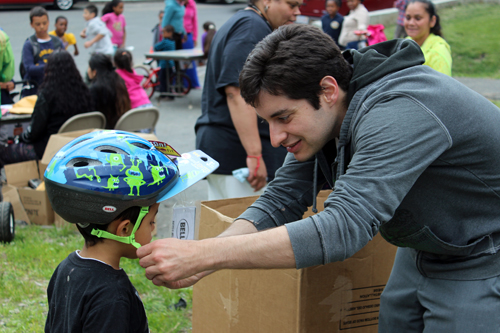 Attorney Sam Segal of Breakstone, White & Gluck helps fit bike helmets at a Boston Bikes event at Orient Heights Boston Housing Authority development.
Attorney Sam Segal of Breakstone, White & Gluck helps fit bike helmets at a Boston Bikes event at Orient Heights Boston Housing Authority development.
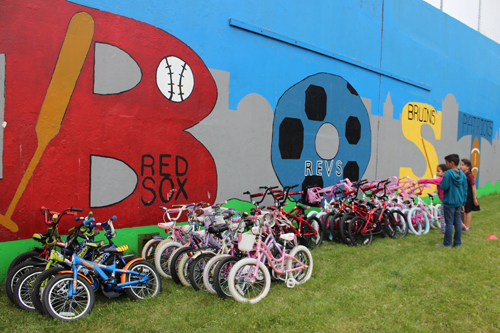 Boston Bikes event at Orient Heights Boston Housing Authority development.
Boston Bikes event at Orient Heights Boston Housing Authority development.
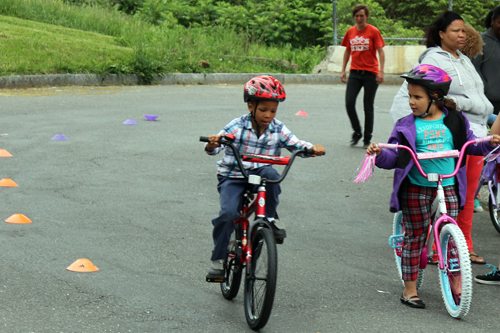 Boston Bikes event at Orient Heights Boston Housing Authority development.
Boston Bikes event at Orient Heights Boston Housing Authority development.
Thompson School in East Arlington. On June 4, the East Arlington Livable Streets Coalition organized a bike safety training for 98 fourth- and-fifth graders at Thompson elementary school. A representative from MassBike spoke to the children about safe riding techniques, proper helmet fitting and bike maintenance. Phil Goff of the East Arlington Livable Streets Coalition also spoke to the children about wearing bike helmets and safety. Breakstone, White & Gluck donated bike helmets to children who showed up without one or needed one that properly fit.
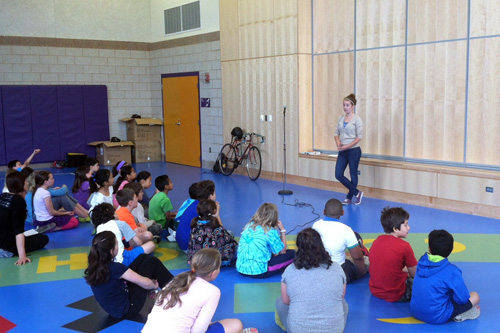 East Arlington Livable Streets Coalition event at Thompson School in East Arlington.
East Arlington Livable Streets Coalition event at Thompson School in East Arlington.
Learn more about Boston Bikes’ Roll It Forward and East Arlington Livable Streets Coalition.
Read More
Bike Helmet Donations in Worcester and Lexington
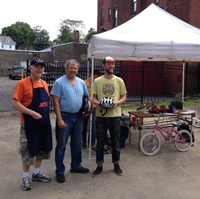 This spring, Breakstone, White & Gluck donated bike helmets to children in several Massachusetts communities, including Boston, Arlington, Framingham, Westborough, Worcester and Lexington. We write about two events here.
This spring, Breakstone, White & Gluck donated bike helmets to children in several Massachusetts communities, including Boston, Arlington, Framingham, Westborough, Worcester and Lexington. We write about two events here.
Worcester Earn-a-Bike. On May 31, attorney David White pitched in at the Worcester Earn-a-Bike’s 4th Annual Kids Bike Sale. Worcester Earn-a-Bike is a community program which teaches fun and affordable bike repair to neighborhood youth and community members. It operates a bike shop which repaired many of the bikes on sale.
At the sale, families got to purchase refurbished bikes for children for just $5! We donated helmets to children who needed one at the sale. Visit the Worcester Earn-a-Bike website to learn more about their work.
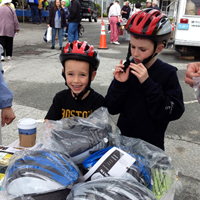 Friends of Lexington Bikeways. On May 24, we donated bike helmets to children through the Friends of Lexington Bikeways and Discovery Day in Lexington.
Friends of Lexington Bikeways. On May 24, we donated bike helmets to children through the Friends of Lexington Bikeways and Discovery Day in Lexington.
If you live in Lexington, you are probably familiar with the Friends, who work to preserve and maintain the Minuteman Commuter Bikeway and other shared use paths. They work closely with the Lexington Bicycle Advisory Committee and each winter, they clear the bikeway of snow for cyclists, cross country skiers and others.
By the way, congratulations to the Friends, the Lexington Bicycle Advisory Committee and the Town of Lexington!
In May, the League of American Bicyclists recognized Lexington as a Bronze Level Bicycle Friendly Community. The League has recognized 303 bicycle friendly communities in the U.S. Massachusetts now has seven communities on the list, including Lexington, Boston, Cambridge, Somerville, Newton, Arlington and Northampton.
Lexington’s application was coordinated by Bicycle Advisory Committee chair Peggy Enders, who also coordinated our donation to the Friends of Lexington Bikeways. Read what she told the Lexington Patch about town’s new recognition.
Visit the Friends of Lexington Bikeways’ website to learn more about their work.
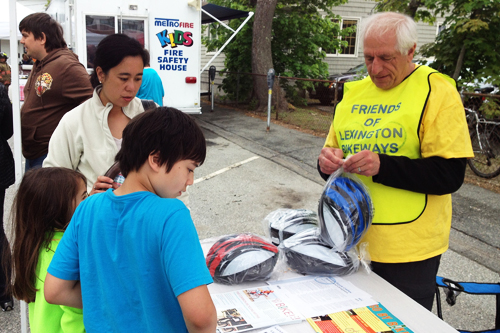
Motorcycle Safety Awareness Month: Safety Reminders and Our Experience Representing Injured Riders
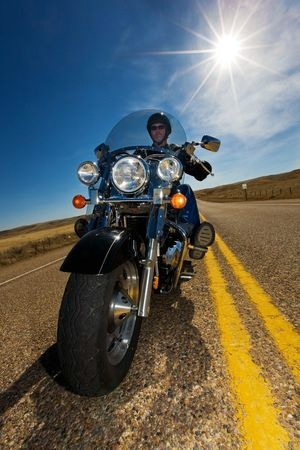 Before June begins, we have a final thought for May, which was Motorcycle Safety Awareness Month.
Before June begins, we have a final thought for May, which was Motorcycle Safety Awareness Month.
Motorcycle use continues to grow in the U.S. but so do motorcycle accidents. For 15 years now, we have seen an annual increase in motorcyclist fatalities, according to the National Highway Traffic Safety Administration (NHTSA). The one exception was 2009. When motorcyclists survive, they are also suffering more non-fatal injuries. In 2012, 93,000 motorcycling injuries were reported, 12,000 more injuries than in 2011.
A few safety reminders for drivers:
- Remember motorcyclists have all the same rights, privileges and responsibilities as other motorists.
- Allow motorcyclists a full lane width.
- Give motorcyclists extra following distance when you are behind them.
- Before you switch lanes, always check your vehicle’s mirrors and your blind spot for motorcyclists.
- Make sure you signal your intention to change lanes or merge with traffic.
- Do not rely on a motorcyclist’s flashing turn signal. The rider may have forgotten to turn it off or it may not be self-cancelling.
A few safety reminders for motorcyclists:
- Remember to wear your helmet and do not let any passengers ride without one. In 2012, overall motorcycle helmet use fell to 60 percent. Passenger helmet use dropped to 46 percent.
- Wear reflective tape whenever possible.
- Do not consume alcohol when you are operating.
- Obey traffic laws. You must have a special license to operate a motorcycle in Massachusetts and that is important. Some 24 percent of all riders who are involved in fatal motorcycle crashes are operating with invalid licenses.
Our Experience Representing Injured Riders
The Boston personal injury lawyers at Breakstone, White & Gluck have over 100 years combined experience handling automobile and motorcycle accident cases.
Read about one case attorney Ronald Gluck handled for an injured motorcyclist. Gluck’s client was seriously injured when a negligent driver cut into his lane and struck his motorcycle. He suffered numerous injuries, including facial fractures, concussions, blindness in one eye and a shoulder injury and had to undergo surgeries. Gluck negotiated a $3.75 million settlement.
Read about the case on our website.
Read the client’s review on Avvo or below.
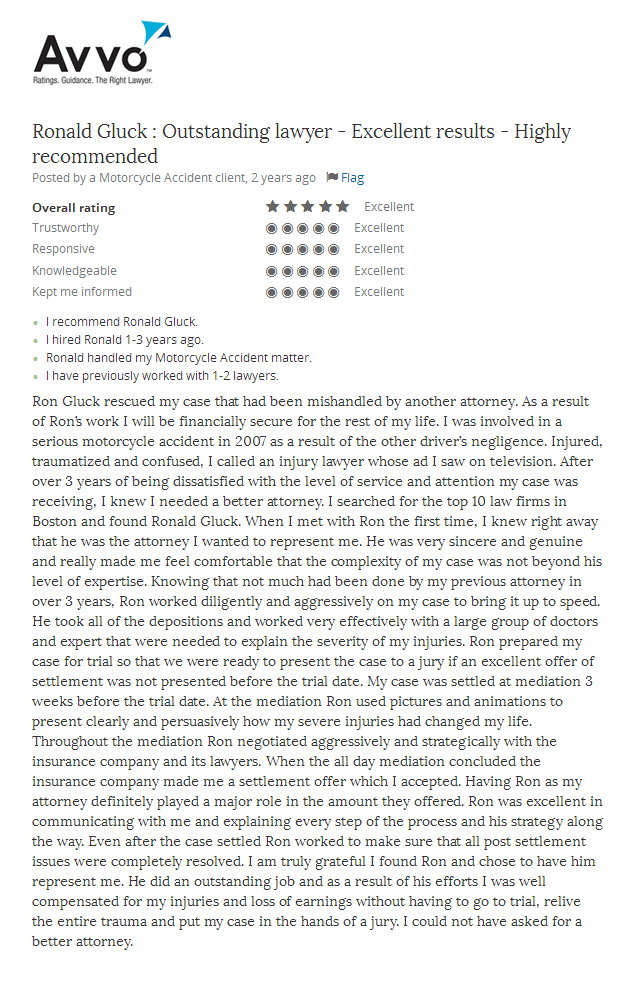
Contact Breakstone, White & Gluck in Boston
If you have been injured in a motorcycle accident, it is important to access immediate medical treatment. Then learn your rights for seeking compensation. For a free legal consultation, contact us at 800-379-1244 or 617-723-7676 or use our contact form.
Unsafe Magnet Toys Buckyballs are Finally Recalled
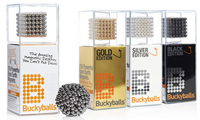 We have written in the past about Buckyballs, a dangerous magnetic desk toy which has injured too many children. Last week came another development, which we hope finally removes this unsafe product from circulation.
We have written in the past about Buckyballs, a dangerous magnetic desk toy which has injured too many children. Last week came another development, which we hope finally removes this unsafe product from circulation.
On May 12, the U.S. Consumer Product Safety Commission (CPSC) announced a voluntary recall for all Buckyballs and Buckycubes. The recall settles an administrative case filed by the CPSC in July 2012. As part of this, Craig Zucker, the former chief executive officer of Maxfield & Oberton Holdings, agreed to establish a Recall Trust. Consumers will be able to request a refund from this fund, which will be controlled by the CPSC. The agency also urges the public to stop using these defective products immediately and look for loose pieces.
Maxfield & Oberton Holdings began selling Buckyballs in 2009. The company said the magnetic desk toy was intended for adults. The problem is if a child starts playing with the tiny magnets, they can swallow them. The magnets can attract inside a child and cause painful intestinal injuries. Surgery is often required and there can be serious longstanding health consequences, such as children having to consume food through a feeding tube.
The CPSC first worked with the company to improve warning labels. The products were marketed for children “Ages 13+” and the CPSC said they should have been marketed for age 14 and up. The company agreed to recall 175,000 magnetic toys and made the change. But the injuries continued. In July 2012, the CPSC filed a lawsuit asking the company to stop sales altogether, a rare legal action the agency has only taken four times in 11 years. The agency alleged that Buckyballs and Buckycubes contained, “a defect in the design, packaging, warnings and instructions, which pose a substantial risk of injury to the public.”
Maxfield & Oberton refused to recall Buckyballs and Buckycubes and in December 2012, the company went out of business. But it was vocal about disagreeing with the CPSC and posted this message on its website:
“Due to baseless and relentless legal badgering by a certain four letter government agency, it’s time to bid a fond farewell to the world’s most popular adult desk toys, Buckyballs and Buckycubes. That’s right: We’re sad to say that Balls & Cubes have a one-way ticket to the Land-of-Awesome-Stuff-You-Should-Have-Bought-When-You-Had-the-Chance.”
In April 2013, six retailers voluntarily recalled Buckyballs and Buckycubes while the CPSC kept trying to raise awareness about the dangers of Buckyballs and other magnetic toys. It established the Magnet Information Center as a consumer resource. Between 2009 and 2011, the CPSC estimates there were 1,700 ER-treated magnet ingestion cases related to high-powered magnet sets.
Zucker will have to eventually fund a website, where consumers can apply for a refund.
Related:
Buckyballs and Buckycubes High-Powered Magnet Sets Recalled Due to Ingestion Hazard; Craig Zucker To Fund A Recall Trust, Settles With CPSC, Consumer Product Safety Commission.
Read More
Nearly 50 Massachusetts Workers Lost Their Lives on the Job in 2013
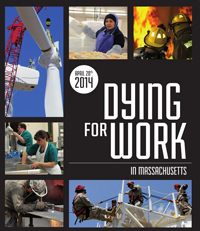 A new report shares hard numbers for Massachusetts workers. In 2013, 50,000 workers were seriously injured on the job and 48 others were killed in workplace accidents. An estimated 480 workers also died from occupational disease, such as cancer from workplace exposure to hazardous materials.
A new report shares hard numbers for Massachusetts workers. In 2013, 50,000 workers were seriously injured on the job and 48 others were killed in workplace accidents. An estimated 480 workers also died from occupational disease, such as cancer from workplace exposure to hazardous materials.
The 2014 “Dying for Work in Massachusetts” report has been released by the Massachusetts Coalition for Occupational Safety and Health (MassCOSH) and the Massachusetts AFL-CIO, which organize the annual Workers’ Safety Memorial Day. On April 28, workers, families of victims, advocates and state officials gathered at the Massachusetts State House for the 26th annual observance.
48 Workers Killed in 2013. The construction industry remains one of the most dangerous, with 11 workers killed in construction accidents in 2013. Workplace falls killed nine workers, causing one-fifth of all occupational fatalities in Massachusetts. Nine other Massachusetts workers were killed by machines and equipment. Workplace violence took the lives of five more workers, including a teacher, a police officer, a livery driver and two store workers.
Commercial fishing accidents killed two fishermen. MassCOSH considers this to be the most dangerous single occupation in Massachusetts. Since 2000, 60 people have died in this work.
The figure also includes nine firefighters who were killed by work-related cancers and heart disease and three servicemen who died in the War in Afghanistan.
Occupational Disease. MassCOSH reports on occupational disease which can develop after an employee is exposed to hazardous materials and dangerous dust. Because symptoms do not immediately present, some conditions are left untreated. Statewide, 480 workers died from occupational disease last year, while another 1,800 were diagnosed with cancers for the first time.
Immigrant Workers. More immigrants died at work last year. In 2012, nine percent of on-the-job deaths were immigrants. In 2013, this figure increased to 19 percent – or nine workers. MassCOSH reports the state’s immigrant workers come from all over the world, including Sir Lanka, El Salvador, India, Angola, Vietnam, Ireland, Cape Verde and Algeria.
Older Workers Face Greater Risk. Workers over age 40 were also at greater risk. The average age of workers who died was 49. The majority – 56 percent – were age 50 or older. Workers over age 60 accounted for 17 percent workplace deaths and construction accident deaths.
OSHA Would Need 123 Years to Fully Investigate in Massachusetts. MassCOSH says OSHA lacks proper funding to investigate and with current resources, would need over 123 years to investigate every Massachusetts workplace under its jurisdiction.
Fines Are Too Small. MassCOSH says fines do little to deter companies from taking safety risks. In 2013, OSHA investigated the deaths of four workers in Massachusetts. All but one settled for $10,000 or less, with an average fine of $6,577.
Related Resources
To learn more, read the MassCOSH annual report, “Dying for Work in Massachusetts: The Loss of Life and Limb in Massachusetts Workplaces.” Page 9 is an “In Memoriam” tribute to the workers who died in 2013.
About Breakstone, White & Gluck
The Boston injury lawyers at Breakstone, White & Gluck support MassCOSH in its work to strengthen laws for worker safety. Our attorneys have over 100 years combined experience representing injured individuals in Massachusetts, including those who have been seriously injured or killed in construction accidents. If you or a loved one have been injured, it is important to learn your rights. For a free legal consultation, contact us at 800-379-1277 or 617-723-7676 or use our contact form.


